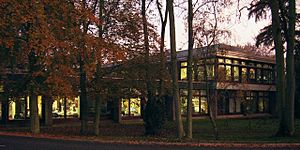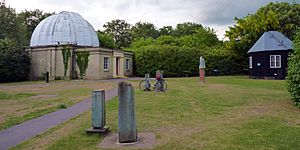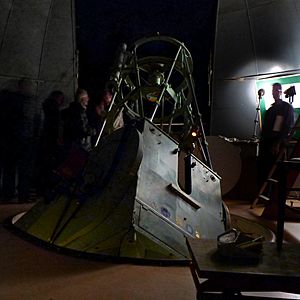Institute of Astronomy, Cambridge facts for kids
 |
|
| Established | 1972 |
|---|---|
| Director | Richard G. McMahon |
| Faculty | School of Physical Sciences, University of Cambridge |
| Staff | 177 |
| Location | |
| Address | Madingley Road |
| Website | www.ast.cam.ac.uk |
The Institute of Astronomy (IoA) is the largest of the three astronomy departments in the University of Cambridge, and one of the largest astronomy sites in the UK. Around 180 academics, postdocs, visitors and assistant staff work at the department.
Research at the department is made in a number of scientific areas, including exoplanets, stars, star clusters, cosmology, gravitational-wave astronomy, the high-redshift universe, AGN, galaxies and galaxy clusters. This is a mixture of observational astronomy, over the entire electromagnetic spectrum, computational theoretical astronomy, and analytic theoretical research.
The Kavli Institute for Cosmology is also located on the department site. This Institute has an emphasis on The Universe at High Redshifts. The Cavendish Astrophysics Group are based in the Battcock Centre, a building in the same grounds.
Contents
History
The Institute was formed in 1972 from the amalgamation of earlier institutions:
- The University Observatory, founded in 1823. Its Cambridge Observatory building now houses offices and the department library.
- The Solar Physics Observatory, which started in Cambridge in 1912. The building was partly demolished in 2008 to make way for the Kavli Institute for Cosmology.
- The Institute of Theoretical Astronomy, which was created by Fred Hoyle in 1967. Its building is the main departmental site (the Hoyle Building), with a lecture theatre added in 1999, and a second two-storey wing built in 2002.
Teaching
The department teaches 3rd and 4th year undergraduates as part of the Natural Sciences Tripos or Mathematical Tripos. In addition, there are around 12 to 18 graduate PhD and masters students at the department per year, mainly funded by the STFC. The graduate programme is particularly unusual in the UK as the students are free to choose their own PhD supervisor or adviser from the staff at the department, and this choice is often made as late as the end of their first term.
Telescopes
The Institute houses several telescopes on its site. Although some scientific work is done with the telescopes, they are mostly used for public observing and astronomical societies. The poor weather and light-pollution in Cambridge makes most modern astronomy difficult. The telescopes on the site include:
- The Northumberland Telescope donated by the Duke of Northumberland in 1833. This is a 12-inch (300 mm) diameter refractor on an English mount.
- The smaller Thorrowgood Telescope, on extended loan from the Royal Astronomical Society. The telescope is an 8-inch (200 mm) refractor.
- The 36-inch Telescope, built in 1951 and thought to be the largest telescope in the UK.
- The Three-Mirror Telescope, which is a prototype telescope with a unique design to have wide field of view, sharp images and all-reflection optics.
The Institute's former 24" Schmidt Camera was donated to the Spaceguard Centre in June 2009.
The Cambridge University Astronomical Society (CAA) both regularly observe. The Institute holds public observing evenings on Wednesdays from October to March.
Public activities
The department holds a number of events involving the general public in astronomy. These include/ have included:
- Open evenings on Wednesdays during the winter, from October to March, with a talk given by a member of the Institute followed by observing in clear weather
- Hosting the Astroblast conference
- Annual sculpture exhibition showing work of Anglia Ruskin University
- Annual open day during the Cambridge Science Festival
- A monthly podcast, the 'Astropod', aimed at the general public
- Extra observing nights for special events such as IYA Moonwatch and BBC stargazing live
Library
The Institute library is housed in the old Cambridge Observatory building. It is a specialist library concentrating on the subjects of astronomy, astrophysics and cosmology. The collection has approximately 17,000 books and subscribes to about 80 current journals. The Library also has a collection of rare astronomical books, many of which belonged to John Couch Adams.
Achievements
Among the significant contributions to astronomy made by the institute, the now decommissioned Automatic Plate Measuring (APM) machine was used to create a major catalogue of astronomical objects in the northern sky.
Notable past members and students
Here are some notable members of the department and its former institutes.
- Suzanne Aigrain
- George Airy
- Robert Stawell Ball
- James Challis
- John Couch Adams
- Donald Clayton
- Arthur Eddington
- Richard Ellis
- Roger Griffin
- Stephen Hawking
- Fred Hoyle
- Jamal Nazrul Islam
- Harold Jeffreys
- Donald Lynden-Bell
- Jayant Narlikar
- Jeremiah Ostriker
- Robert Woodhouse





